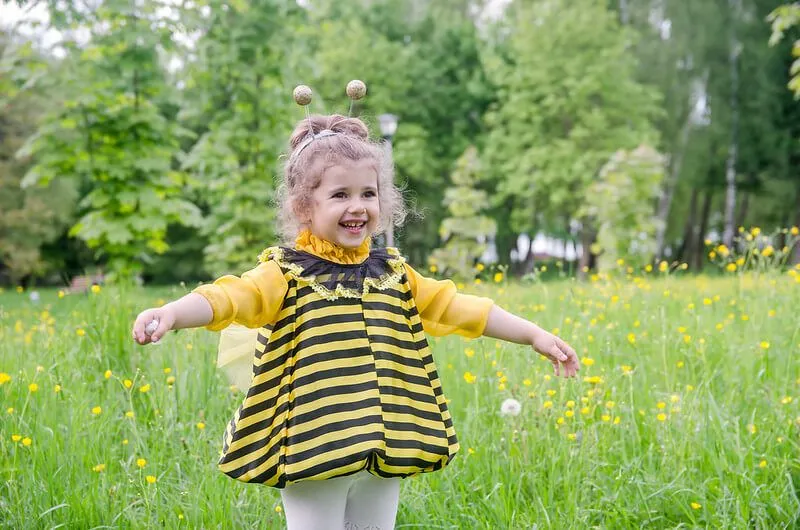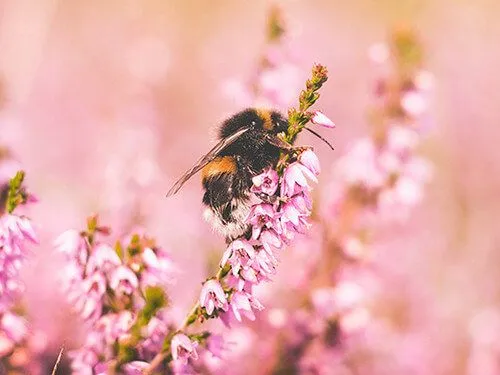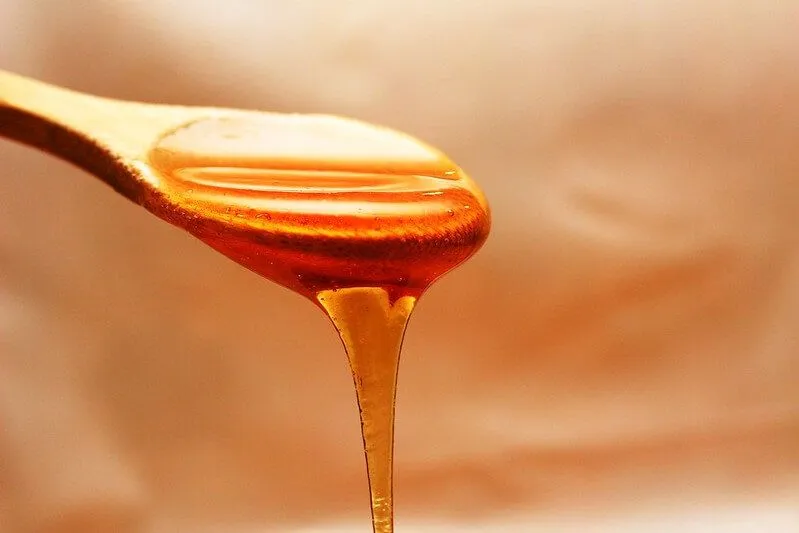FOR ALL AGES
There’s lot to celebrate in our gardens this week; the garden centres are open, the virtual Chelsea Flower Show is running and we have beautiful weather. This article focuses on bees. Read on for tips to educate your little ones about the importance of bees and take steps to make your family garden a bee paradise!
When you savour a sweet strawberry or admire a wild rose in a hedgerow, you owe such simple pleasures to bees.
Bees are ninja pollinators and are responsible for pollinating up to 80% of the fruit and vegetables we enjoy, and the delicate wildflowers we appreciate.
Bees help to keep the circle of life buzzing along. They provide vital food for humans, birds, insects and animals and don’t ask for much in return.
Tragically bee colonies are declining around the world due to a combination of climate change, pesticides, and destroyed habitats. Luckily, there is plenty we can all do in our gardens (no matter the size) to help.

1) If you have a lawn, try to leave an area unmown.
Unmown grass not only makes a fun den for the kids, but it also encourages wildflowers like dandelions and daisies to grow which are precious sources of nectar for bees. If you want to create a beautiful meadow with a variety of wildflowers you can order seed balls and get your kids to scatter them so that they feel invested in the process.
2) Think about year-round flowering.
Bees hibernate in the winter, but as our winters are increasingly mild, they hibernate for shorter periods. As soon as the temperature reaches 10 degrees or above, bees start foraging again. To ensure there is enough pollen and nectar for bees to collect, grow flowering plants in the winter such as hellebores, crocuses, cyclamen and snowdrops. Teaching children about what flowers to expect during the different seasons is a great way to fuel their interest in nature.
3) Try not to plant too many red flowers.
Bees see the colour red as black so they always avoid red flowers. Instead bees are particularly drawn to blue, violet, purple, pink or white flowers. To get your children involved, you could ask them to count how many bee friendly flowers are in the garden versus how many red flowers. You do not need to remove any red flowers, but if the balance is off, it could inform your choice for the next garden centre trip!
4) Try to avoid planting too many ornamental or overly bred flowers.
Honeybees have short tongues which means they struggle to extract pollen and nectar from overly bred or ornamental flowers such as dahlias. Instead honeybees love simpler flowers in their original form where they can easily extract food. Encourage your children to explore the flowers in the garden and run an inventory on which flowers have readily available pollen and nectar sources. Good bee-friendly flowers to look out for in May are alliums, lavender, hawthorn and daisies.
5) Plant in clumps
Bees will only visit one type of flower up to 100 times on a single foraging trip, so make their life easier by reducing their travel time from flower to flower. If you have the space, plant the same variety of plant multiple times. If you have a balcony you could plant the same type of flower in multiple pots. Get your children involved with a spade, some compost and a watering can.
6) Build a Bee bath
Water is used to regulate the temperature of the hive. It is not stored in the hive itself, so bees need to make frequent trips to collect it. If you have a pond or a water-feature you are doing brilliantly, but if not, your children could create their very own bee bath using a bowl and some stones and wait for it to fill with rainwater.
7) Build a bee hotel
Not all bees live in a hive, so you and the kids could build a bee hotel to take care of the solitary bees. Bee hotels create a safe environment for solitary bees to nest. This article has some great instructions.

SPRING
Bluebell, Crab apple tree, Cherry tree, Forget-me-not, Hawthorn, Rosemary, Borage
SUMMER
Delphinium, Foxglove, Hardy geranium, Hollyhock, Snapdragon, Lavender, Thyme, Buddleja, Cornflower
AUTUMN
Dahlia (single petaled open varieties), Autumn clematis, Cosmos, Michaelmas Daisy
WINTER
Primrose, Winter crocus, Hellebores, Cyclamen, Willow trees, Snowdrops
And if you are still interested…

1. The Queen bee rules the hive
There is only ever one queen in the hive, and she is responsible for reproducing all the offspring. Her other main function is to produce pheromones that give the hive its own identity to prevent intruders from other hives entering. Queens are fed nothing but royal jelly which sets them apart from other bees in the hive. Worker bees always have fertilized queen eggs on standby if the hive is preparing to swarm, or as backup if the current queen is getting old. You can spot a Queen as she will have longer legs and bigger abdomen. She will also move slowly around the hive.
2. Worker bees run the hive
Worker bees make up 98% of the hive which in a productive hive can be up to 60,000 bees! Workers are all female. They are very busy: They nurture the young, build the hive, clean the hive, guard the hive, forage for pollen and nectar, and make the honey.
3. Drones have no sting
There are only a few hundred drones in a hive. You can spot drones by their huge eyes, chunky body and fat hairy backs. Their one purpose is to mate, so they have no sting. They fly around very high in the sky looking for queen bees. At the end of the summer the worker bees kick them out of the hive to preserve energy to nurture the young.
4. Honeybees are not lazy
In a single foraging journey, a honeybee will visit around 100 flowers, and in a single day that same honeybee can make up to 15 trips to and from the hive.
5. They stick to what they know
Whilst out foraging, a honeybee will only collect nectar and pollen from one type of flower approximately 100 times, this is known as flower fidelity.
6. Always think ahead
Honeybees are the only type of bee that store honey in their hive to ensure the colony will survive over winter. As the colony reaches its peak in population in early summer it focuses on collecting nectar and pollen to store honey for the coming winter.
7. On the hunt
When worker bees go foraging, they are on the look out for nectar, pollen, tree resin and water.
- Nectar is collected to create honey.
- Pollen to create royal jelly which is used to feed the brood and create a Queen.
- Resin from buds and tree sap to create propolis which is the binding material in the hive that protects it from disease due to its antibacterial properties.
- Water to regulate temperature in the hive
Katy Gardener is perfecting her green thumb over at Becoming A Gardener - follow her adventures!
Read The Disclaimer
At Kidadl we pride ourselves on offering families original ideas to make the most of time spent together at home or out and about, wherever you are in the world. We strive to recommend the very best things that are suggested by our community and are things we would do ourselves - our aim is to be the trusted friend to parents.
We try our very best, but cannot guarantee perfection. We will always aim to give you accurate information at the date of publication - however, information does change, so it’s important you do your own research, double-check and make the decision that is right for your family.
Kidadl provides inspiration to entertain and educate your children. We recognise that not all activities and ideas are appropriate and suitable for all children and families or in all circumstances. Our recommended activities are based on age but these are a guide. We recommend that these ideas are used as inspiration, that ideas are undertaken with appropriate adult supervision, and that each adult uses their own discretion and knowledge of their children to consider the safety and suitability.
Kidadl cannot accept liability for the execution of these ideas, and parental supervision is advised at all times, as safety is paramount. Anyone using the information provided by Kidadl does so at their own risk and we can not accept liability if things go wrong.
Kidadl is independent and to make our service free to you the reader we are supported by advertising.
We hope you love our recommendations for products and services! What we suggest is selected independently by the Kidadl team. If you purchase using the buy now button we may earn a small commission. This does not influence our choices. Please note: prices are correct and items are available at the time the article was published.
Kidadl has a number of affiliate partners that we work with including Amazon. Please note that Kidadl is a participant in the Amazon Services LLC Associates Program, an affiliate advertising program designed to provide a means for sites to earn advertising fees by advertising and linking to amazon.
We also link to other websites, but are not responsible for their content.
Was this article helpful?



Browse Category



We’ll send you tons of inspiration to help you find a hidden gem in your local area or plan a big day out.



Check your inbox for your latest news from us. You have subscribed to:
Remember that you can always manage your preferences or unsubscribe through the link at the foot of each newsletter.